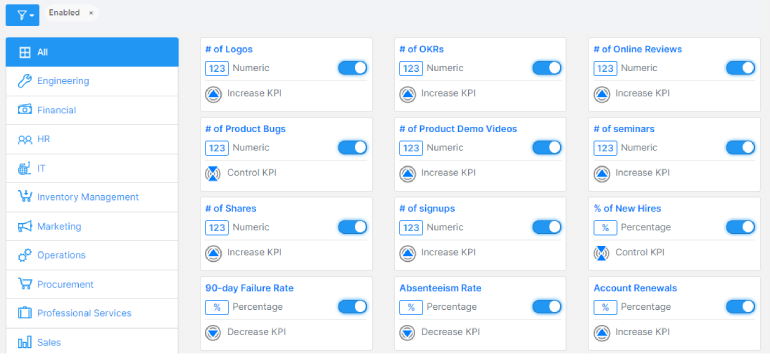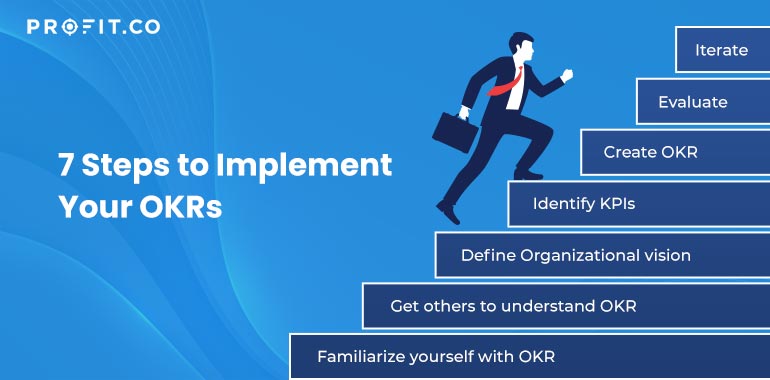Industry-leading companies have famously used OKRs to better measure and achieve their goals. Google, Amazon, Spotify, and more technology giants have attributed much of their unprecedented success to the goal-setting framework.
Businesses of all sizes can benefit from OKRs. However, this framework need to be implemented and used correctly in order for teams to truly find success. So, the question is: how do you implement your OKR program?
While learning new terminology and encouraging new habits within your company culture can seem daunting at first, you can implement your OKR program by following these seven steps:
- Familiarize yourself with OKR
- Get others to understand OKR
- Define/Refine your company’s vision
- Identify KPIs
- Create OKR
- Evaluate
- Iterate
Step 1: Familiarize yourself with OKR
Defining an OKR is easy. Objectives and Key Results, or OKRs in short, is a rigorous goal setting and tracking method invented by Andy Grove and used by industry giants like Intel and Google. Andy Grove derived the concept of OKR from the teachings of Peter Drucker’s Management by Objectives.
If you’re at this article, you’re probably familiar with the OKR framework. Now, you might be wondering how to implement OKRs.
To begin implementing OKRs, ask yourself the following questions: what do I know about OKRs, and how is it going to help my organization achieve its goal? If you are the one implementing OKRs to your peers and employees, familiarizing yourself with the conceptual and motivational aspects of the framework is a great way to determine how to implement OKRs.
To begin implementing OKRs, start with the fundamental approach of trial and error to set up sample objectives, key results, and also a few underlying tasks. Assess alignment and sharing opportunities across various departments. Once you understand the nuts and bolts of creating and tracking OKRs, you’ll be ready to share the usefulness of this methodology and it’s best practices across your organization.
Step 2: Get others to understand OKR
While it’s true that many will instantly recognize the value of implementing OKRs, it’s likely to come across skeptics within your organization. And that’s okay! It’s healthy to encourage an atmosphere of public discourse in which members of your team feel comfortable engaging in productive conversations and expressing their concerns as you find out how to implement OKRs.
As you seek to gain the support of teams and individuals, it’s crucial that you clearly and transparently explain the many benefits of implementing OKRs, how it will help the organization as a whole to reach desired objectives, and how it facilitates individual success.
Organize workshops, seminars, and discussions to help various departments understand how to create quality OKRs. Teach employees how to update, report, track, align, and share OKRs. It’s also a good idea to get your team started with a powerful and intuitive OKR software such as Profit.co, a leading software solution to the strategic execution of objectives and key results.
Ready to implement your OKRs for FREE?
Step 3: Define/Refine your company’s vision
The main purpose of OKR is to steer all organizational developments and achievements towards the ultimate, purposeful vision of the organization. This insight is often lost when organizational size grows. Defining the scope and profundity of your vision will guide other OKRs tailored to it.
Step 4: Identify KPIs
A pillar of implementing OKRs correctly is ensuring you use the right KPIs– or Key Performance Indicators. KPIs enable organizations to look at present/past results, identify their position in the business cycle, and analyze strengths and weaknesses.
For all variation in growth trends one might witness in any business cycle, the key is to have a good hold on KPIs responsible for that specific trend. Identifying which KPIs are to be increased, decreased or maintained, forces you to look at what measurable actions and behaviors will drive you towards specific goals.
It is important to sit down and decide which KPI you want to make use of, and which results will help boost your production or outreach.
For example, if your goal is to Increase Customer retention rate by 30%, determine what other factors like NPS Score, Average order value, Customer lifetime value serves the above purpose. Then, establish some specific, actionable steps to achieve the goal.
It is easy for a company to get lost in the scramble of KPIs until it becomes a jumbled mess of information that the user cannot keep straight. Use what will be the most fundamentally important information for your particular needs in alignment with organizational OKRs.

Step 5: Create OKR
It can be tough, even intimidating, to identify an objective structure that works well within the OKR program you have implemented for your company. Your OKR bears the heavy burden of laying out the framework for your overarching objectives and organization goals.
Therefore, you must clearly communicate expectations to your teams and leadership alike as you are implementing OKRs in your organization. This serves to address any questions or concerns your teams may have and also lays the groundwork for successfully implementing OKRs.
Six tips for successful and effective implementation of OKRs
- Inspire and engage
- Take a reality check
- Avoid ambiguity
- Be transparent and time-bound
- Keep fit in mind
- Teamwork makes the dream work
You must strike the delicate balance of creating goals that challenge your team to rise to ambitious heights, but also motivate them to work towards an objective that they believe in
If the method you implement is too complicated and troublesome to interact with, then your company faces the risk of maintaining your OKR becoming too much of a task on its own. You don’t want to create a new burden that’s unrealistic to keep up.
OKRs must clearly define its scope and be easily understandable from the company’s standpoint
The whole point of creating OKRs is to have complete transparency across the organization. Being time-bound keeps a constant check on daily, weekly, monthly, quarterly and annual deadlines, ensuring all the updates and trackables are in place.
The right objective for an auto dealership is not the same as the right objective for a high-end chocolatier. When you choose the objectives that serve as the framework for your OKR, it is crucial that you keep in mind the factors specific to your company and your industry.
Your objectives are what will drive your business ever onward in its pursuits toward growth and success. So if the goals you set are ones that stand in direct opposition to the mission, culture, and vision of your company, then those objectives are doomed to fail.
Your team is your most valuable resource toward attaining absolutely any goal or objective. Use the knowledge and input of your teams to inform your best next step and identify the right objective for your company.
Step 6: Evaluate
As your implementation of OKR proves a valuable tool for your company, it’s very likely that the OKR method will expand to other departments and ventures. But writing OKR is a skill set, and one that takes time and patience to develop.
Allow some time for growth and adjustment among your teams! Understand that your team and various department heads will require your patience and understanding as they develop their OKR skills.
Take the time to perform an evaluation to figure out what worked and what didn’t. Such feedback is critical to making changes in the future.
Step 7: Iterate
By now you will have a fair understanding of how to implement OKRs and measure what really matters. Iteration is necessary for ambitious growth. This gives you a base to effectively improve and innovate your OKRs.
Almost inevitably, your organization will cross something that improving an objective simply cannot address. It’s not that you need to create something new, not that you need to revise something that already exists: it’s just that something needs to change completely with an out-of-the-box approach.
The OKR methodology is particularly conducive to improving objectives as it provides flexibility to modify and adapt across the various teams and individuals who contribute to its ultimate objective. The same timeline and rhythm is not applied to every team — the approach is customized according to key result and according to the timelines and resources available to those to whom the key result has been assigned. This practice maximizes flexibility within your OKR program and provides multiple opportunities to readjust and allow for structural changes as your timeline progresses. This agility paves a way to construct and reconstruct your run towards the goal.
If you want an agile and intuitive OKR approach and guidance on how to implement OKRs in your organization, you need Profit.co. Profit.co OKR management tailors directly to the needs of your business.
